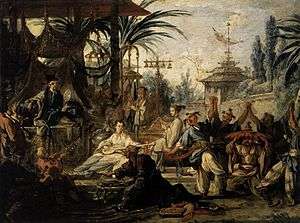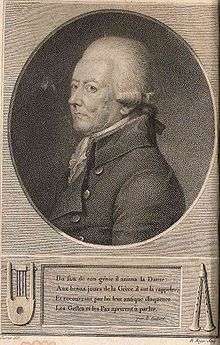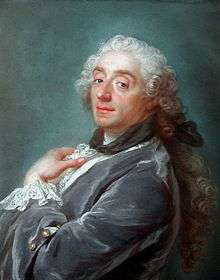Les Fêtes Chinoises
Les Fêtes Chinoises is an 18th-century ballet by Jean-Georges Noverre (1727–1810). The exact date of the ballet's composition is unknown but it was probably created in 1751 for Marseilles, where Noverre was ballet master. Revivals followed in Lyon and Strasbourg and the ballet was staged in Paris on Monday, 1 July 1754 at the Opéra-Comique, with decors by François Boucher. Les Fêtes Chinoises had little in the way of plot or theme but instead was a series of danced pictures inspired by the Chinoiserie designs of the Rococo that embroidered upon descriptions of China by travellers and explorers. The ballet was Noverre's first great success. The 1755 London production was completely destroyed by anti-French rioters on the eve of the Seven Years' War.[1]

Background

Jean-Georges Noverre was born in Paris 29 April 1727 and studied dance under Louis Dupré. He began his professional career in 1743 with appearances at the Opéra-Comique in Paris. There, he learned to direct gesture and movement and observed the Italian comedians with their emphasis on improvisational and physical theatre. Before Noverre there was no dance technique involved in ballets; such spectacles were loosely organized around a story or theme, but the dance movement itself was largely formal and ornamental, with only a very limited range of mime gestures to convey the action.[2] He used this new, revolutionary production as a response and a contrast to the ballets of the time. "Noverre points out, this kind of performer is rare. He…thinks that the actor-dancer must rise to the challenge of translating a verbal description into stage action, that this involves not just performance, but interpretation."[3] At the age of twenty Noverre became ballet master in Marseilles and choreographed Les Fêtes Chinoises to music probably by Jean-Philippe Rameau, though Noverre did not specify a composer in his libretto. The ballet was first performed in 1751 or earlier, possibly at Marseilles or Strasbourg. After brief artistic sojourns in Lyon (where the ballet was revived during the 1751 season) and Strasbourg, Noverre returned to Paris in 1754. Les Fêtes Chinoises was staged in a production by the impresario Jean Monnet at the Opéra-Comique on 1 July 1754 to great acclaim.[4][5]
The ballet designs were the fruit of Boucher's friendship with Jean Monnet, which had resulted in designs for Monnet at the Théâtre de la Foire de Saint Laurent "as early as 1743."[6] Le Nouveau Calendrier des spectacles de Paris described the scene of Les Fêtes Chinoises as "an avenue ending in terraces and a flight of steps leading to a palace" then changing to a public square decorated for a festival and continuing with subsequent scene shifts of which the Calendrier remarked "M. Monnet has spared nothing that could possibly assist M. Noverre's rich imagination".[2]
Les Fêtes Chinoises was semi-realistic in style and consisted of danced pictures with little plot. Elements of the real and the ideal were incorporated into the work, which evoked the exotic China of travellers and explorers, and the fantastic Cathay of the chinoiserie designers of the Rococo.[note 1][1] Instead of presenting miscellaneous divertissements or a suite de danses, Noverre went beyond traditional court ballets in Les Fêtes Chinoises to create a cohesive, integrated work consistent in locale and atmosphere, and one which focused on a single rich style with little dramatic action. Such a presentation was, for his audience, something new and striking.[7] In the early years of his career, Noverre felt all types, nationalities, and conditions of men were fit for depiction in dance, but at the close of his career he recanted and wrote that only nobly born heroes and heroines (mostly of antiquity) were appropriate for the dignity of stage dancing.[8] Late in life he took a dislike to Les Fêtes and omitted it from his published librettos.[1]
Plot summary
J. des Boulmiers, an eyewitness to a performance of Les Fêtes Chinoises wrote:
[...] a public square decorated for a festival with, in the background, an amphitheatre on which are seated sixteen Chinese [and] thirty-two are seen on the gradins (stepped tiers) going through a pantomime. As the first group descends, sixteen further Chinese, both mandarins and slaves, come out of their habitations [...]. All these form eight rows of dancers who, rising and dipping in succession, imitate fairly well the billows of a stormy sea. All the Chinese, having descended, begin a character march. There are a mandarin, borne in a rich palanquin by six white slaves, whilst two negros draw a chariot on which a young Chinese woman is seated. They are preceded and followed by a host of Chinese playing various musical instruments [...]. This march concluded, the ballet begins and leaves nothing to be desired either in the diversity or in the neatness of the figures. It ends in a contredanse of thirty-two persons whose movements trace a prodigious number of new and perfectly designed attitudes, which form and dissolve with the greatest of ease. At the end [...] the Chinese return to their place on the amphitheatre, which is transformed into a china cabinet. Thirty-two vases, which rise up, conceal [...] the thirty-two Chinese one saw before.[8][9]
Considering that most performances (theatrical and ballet) before this took place in either the royal courts or in inn yards, taverns, or pubs, having that many people on the stage at one time was unheard of. However, Lincoln Kirstein adds that it "consisted of dance pictures with little plot, incorporating elements of the real and ideal, including the exotic China of travelers and explorers and the fantastic Cathay of Rococo chinoiserie designers." [1] Furthermore, the costumes were "untraditional"—they were based on Roman armor and had Chinese embellishments on them.[8]
Paris production, 1754

The Paris production's splendid décor, ingenious round dances, and its large and superbly schooled corps de ballet astonished and delighted audiences, which had yet to behold anything quite so marvellous. While there was likely nothing profound in the ballet's theme, for the first time there was an integrated conception of costume, décor, properties, and movement subordinated to the development of a stage picture, and theatre-goers attended to see the ballet as such, not the virtuoso in vogue. Musical instruments such as the triangle and cymbal ("Turkish music") were first introduced in the ballet though it is not certain whether they were played in the orchestra or only used as stage properties.[10] The costumes were designed by Louis-René Boquet, who forsook the traditional ballet uniform of Roman armour with applied bits of Chinese decoration for full-scale and realistic Chinese costumes.[8] The décor was created by Guillet and Moulin and possibly Leuse, after designs by François Boucher.[note 2] They were worked up into full-scale cartoons by Jean-Joseph Dumons, and woven nine times, first in 1743 and last in 1775, when their rococo pastorale galante would have begun to seem a bit stale. The Chinese Fair from the series, at Cleveland, is illustrated by Landau 1983, fig. 20.[11][12]
Reception
Les Fêtes Chinoises was Noverre's first great success. In a grudging journal entry the dramatist Charles Collé remarked in July 1754: "This month, all Paris has flocked to a Chinese ballet, given at the Opéra Comique. I do not like ballets, and my aversion to dancing has greatly increased since all the theatres have become infected with ballets; but I must admit that this Chinese ballet is unusual and at least by its novelty and its picturesqueness it has earned a share of the applause it is given."[13] On 1 July 1754, the Mercure de France observed that the ballet was mounted with extraordinary luxury and in August reported that "the multitude flocked to see it with unprecedented furore."[9]
London production, 1755
Les Fêtes Chinoises was presented in London with new machinery and décor by Boquet under the title Les Métamorphoses Chinoises on 8 November 1755 following negotiations between David Garrick, proprietor of Drury Lane Theatre (who appreciated ballet, had married a ballerina, and was looking for a theatrical novelty), and Jean Monnet, the licence holder at the Opéra-Comique. One commentator remarked:
The sets were superb and the costumes magnificent. Ninety persons appeared in the march. The palanquin and the cars were richly decorated. All the wings were embellished with balconies filled with Chinese men and women spectators of the fete. The corps de ballet were well composed and well grouped, the individual pas agreeably varied, and the contredanse was executed with a precision and neatness unusual in grands ballets [...].[8]
Threats of war between Britain and France, however,[note 3] and English antagonism to French dancers led to riots in which Boquet's costly décors and machines were destroyed, and the theatre and its accessories extensively damaged. Garrick sustained a loss in the thousands of pounds.[8] Noverre and his family were forced to go into hiding after the ballet master's brother Augustin wounded a man in the mêlée.[14] Noverre remained in England for a period time after the riots supervising dance spectacles at Drury Lane but without billing. He left London for Lyon in March 1757.[15]
References
- Notes
- Following Marco Polo's travels to China, Europe developed a growing fascination with Chinese decorative arts. Lacquers, porcelains, tapestries, and ceramics were highly prized. By 1601, a ballet of Chinese princes dressed in feathers, mirrors, and black and white was produced and in 1700 Saint-Simon noted that a ball at Versailles was supplemented with "booths for the merchants of various countries—China, Japan, etc. —offering vast quantities of objects of beauty and vertu [...]." In 1723, the stage work Arlequin Pagode et Médicin displayed a backdrop depicting the Imperial Palace in Peking; in 1751, the French Academy in Rome gave a procession in Chinese style to honor Madame de Pompadour's brother; and in 1755, Voltaire's L'Orphelin de la Chine dramatized Confucian morals. The painter François Boucher may have actually depicted Noverre's theatrical China in a series of tapestry cartoons.
- Boucher had improvised on chinoiserie themes for a Beauvais tapestry suite La Tenture chinois. Boucher showed eight designs for the hanging at the Salon of 1742; they were described in the livret as "Huit esquisses de differents sujets chinois, pour être exécutées en Tapisseries à la Manufacture de Beauvais" (reprinted in Colin B. Bailey, Philip Conisbee, Thomas W. Gaehtgens, The age of Watteau, Chardin, and Fragonard: masterpieces of French genre painting [exhibition catalogue, 2003] under date 1742, p. 394).
- The Seven Years' War opened with Frederick the Great of Prussia's invasion of Saxony and was followed by Britain and France declaring war 18 May 1756.
- Footnotes
- Kirstein 1984, p. 110
- Landau 1983, p. 375
- Nye 2014, p. 155
- Kant 2007, pp. 87–88
- Mackrell 2014
- Landau 1983, pp. 360–378
- Kant 2007, p. 94
- Kirstein 1984, p. 111
- Lynham 1950, p. 21
- Lynham 1950, p. 22
- Bailey, Conisbee & Gaehtgens 2003, p. 394
- Jarry 1981, p. 25f
- Sorell 1967, p. 126f
- Lynham 1950, p. 39
- Lynham 1950, p. 50
- Bibliography
- Bailey, Colin B.; Conisbee, Philip; Gaehtgens, Thomas W. (2003), The Age of Watteau, Chardin, and Fragonard: Masterpieces of French Genre Painting, Yale University Press, ISBN 978-0-300-09946-1
- Jarry, Madeleine (1981), Chinoiseries: le rayonnement du goût chinois sur les arts décoratifs des xviie et xviiie siècles, Fribourg: Office du Livre
- Kant, Marion, ed. (2007), The Cambridge Companion to Ballet, Cambridge Companions to Music, Cambridge and New York: Cambridge University Press, ISBN 978-0-521-53986-9CS1 maint: ref=harv (link)
- Kirstein, Lincoln (1984) [1970], Four Centuries of Ballet: Fifty Masterworks, New York: Dover Publications, Inc., ISBN 0-486-24631-0
- Landau, Ellen G. (November 1983), "A Fairytale Circumstance;: The Influence of Stage Design on the Work of François Boucher", The Bulletin of the Cleveland Museum of Art, 70 (9)
- Lynham, Deryck (1950), The Chevalier Noverre: The Father of Modern Ballet, London: Sylvan Press
- Mackrell, Judith R. (2014), "Dance", Encyclopædia Britannica
- Nye, Edward (2014), Choreography is Narrative: The Programmes of the Eighteenth-Century Ballet d'Action, Project Muse <http://muse.jhu.edu/journals/dance_research/v026/26.1.nye.html>: Johns Hopkins UniversityCS1 maint: location (link)
- Sorell, Walter (1967), The Dance Through the Ages, New York: Thames & Hudson